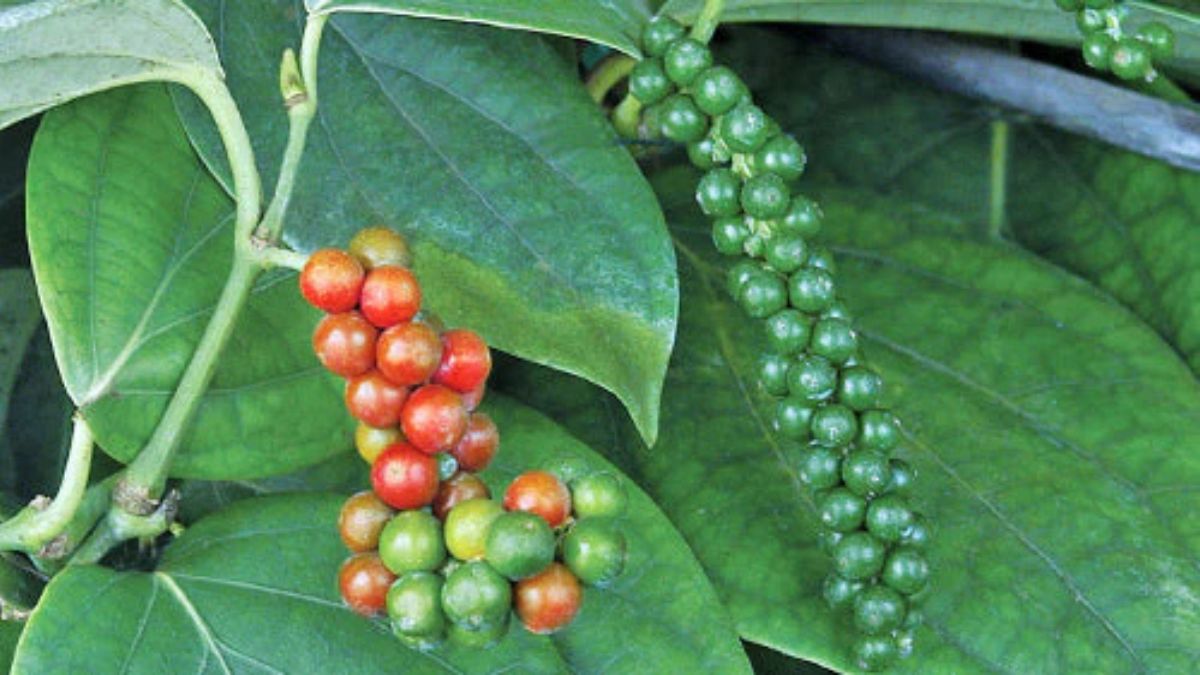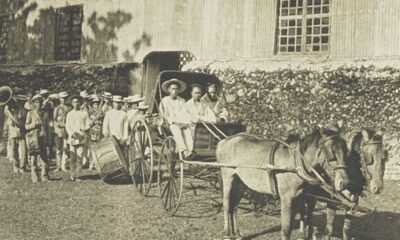TOPIC
The Peppercorn Plant: The Little Vine That Spiced the World

There are plants that feed us, plants that heal us, and then there’s the peppercorn — Piper nigrum, the vine that taught humanity to crave flavor. Long before sugar sweetened our tongues or chocolate seduced our senses, pepper ruled the world. Kingdoms were traded for it, oceans were crossed for it, and wars — yes, actual wars — were waged for its tiny, aromatic beads.
Today, it sits unassumingly on your dinner table, next to the salt shaker, its grandeur reduced to a twist of the wrist. But the story of the peppercorn plant is no less than a global epic — a tale of greed, beauty, resilience, and the world’s most enduring addiction to taste.
1. Meet the Plant That Changed History
Let’s start at the root — or rather, the vine.
The peppercorn plant, Piper nigrum, is a tropical climber native to the lush forests of the Western Ghats in India, particularly the Malabar Coast of Kerala. It’s part of the Piperaceae family, which boasts over a thousand species. But nigrum? That’s the rockstar. The origin of the world’s black, white, and green peppercorns.
It’s a perennial woody vine that can stretch over 10 meters if left unchecked, winding around tree trunks like an emerald serpent. Its heart-shaped leaves shimmer in shades of glossy green, and when it blooms, it does so modestly — tiny white flowers that eventually mature into clusters of berries known as drupes.
These drupes are where the magic lies. Harvest them young, dry them in the sun, and they wrinkle into black peppercorns. Strip them of their outer skin, and you’ve got white pepper. Pluck them before they ripen, preserve them — voilà, green peppercorns.
From one plant, a trinity of flavors. A single vine can feed an empire of taste.
2. A Spice That Mapped the World
The peppercorn’s story is not just botanical — it’s geopolitical.
Long before GPS and Google Maps, pepper was the original global motivator. It shaped trade routes, birthed empires, and turned humble merchants into magnates.
As far back as 2000 BCE, pepper was making its way from India to ancient Egypt, where archaeologists later discovered peppercorns stuffed into the nostrils of Pharaoh Ramses II — part of his mummification ritual. That’s right — pepper was valuable enough to follow kings into the afterlife.
The ancient Romans were obsessed. Pliny the Elder complained that “no year sees an end to the consumption of pepper,” and lamented how much gold Rome poured into India to keep the spice flowing. Pepper was currency, luxury, and status symbol all at once.
By the Middle Ages, the “spice routes” running from India through Arabia and into Europe were some of the most lucrative corridors on Earth. Venice, with its control over Mediterranean trade, became rich beyond measure. Merchants didn’t just measure their worth in gold — they measured it in pepper.
A wealthy man was, quite literally, a peppercorn magnate.
And then came the great disruption — the Age of Exploration. Portugal, weary of paying Venice’s prices, sent ships around Africa in search of direct spice access. Vasco da Gama’s 1498 landing in Calicut wasn’t just a geographical milestone; it was the beginning of global capitalism. All for those little black pearls.
The peppercorn plant, in a sense, mapped the world.
3. Cultivating the Vine of Power
So, how does one grow the plant that redefined civilization?
Pepper thrives in hot, humid, tropical climates — the kind where the air feels heavy and alive. It’s a lover of filtered sunlight, preferring to climb up support trees like areca nut or coconut palms. Farmers usually plant the vines in loamy, well-drained soil with plenty of organic matter.
It takes patience. Pepper vines take three to four years to start yielding fruit, and they keep producing for up to twenty years. Harvesting is an art: pick the spikes when one or two berries turn red, then dry them under the sun for several days until they wrinkle into the familiar black spheres.
A single vine can yield up to two kilograms of dried peppercorns annually — not bad for a plant that shaped human destiny.
Modern cultivation spans across tropical Asia — India, Indonesia, Vietnam, Malaysia, and Sri Lanka — with Vietnam now leading global production. But the Malabar Coast remains sacred ground: the birthplace of pepper’s legend.
4. From Vine to Table: The Alchemy of Pepper
Here’s the real trick — all the types of pepper you’ve seen in your kitchen come from the same plant. The difference lies in how they’re processed.
-
Black pepper: The unripe green berries are cooked briefly in hot water, then dried. The wrinkled outer skin gives the pepper its bold, aromatic kick.
-
White pepper: The ripe berries are soaked to remove the dark outer skin, leaving the pale inner seed. The result? A milder, earthier flavor.
-
Green pepper: Unripe berries preserved in brine or freeze-dried, known for their fresh, herbal sharpness.
-
Red peppercorns: Fully ripened and dried, rare and intensely aromatic.
Each type tells a story of timing, care, and technique — a reminder that sometimes, the smallest decisions yield the biggest differences.
5. Chemistry of the Kick
The peppercorn’s fiery charm comes from a chemical called piperine. Unlike chili’s capsaicin, which burns with heat, piperine teases the tongue — a slow, tingly burn that enhances perception of other flavors.
That’s why chefs call pepper the “universal amplifier.” It doesn’t overpower; it elevates.
But piperine is more than a culinary thrill. Science shows it boosts digestion, enhances nutrient absorption, and even increases the bioavailability of compounds like curcumin from turmeric — a classic example of how Indian cooking mastered nutritional synergy centuries ago.
And let’s not forget the aroma — the volatile oils that make freshly cracked pepper smell almost floral, citrusy, and woody all at once. It’s complex, sensory poetry in a grind.
6. The Economics of a Tiny Bead
Pepper has always danced on the edge between everyday staple and luxury commodity.
Even today, the global pepper market is worth billions. The price fluctuates wildly with weather, crop yield, and export demand. In Vietnam — which supplies over 35% of the world’s pepper — a bad monsoon season can shake the entire industry.
In Kerala, pepper still carries an aura of prestige. Smallholders tend to the vines with almost spiritual devotion. A good harvest can pay school fees, buy gold jewelry, or fund a wedding.
The peppercorn, despite its size, remains a symbol of prosperity — a living link between agriculture and aspiration.
7. Myths, Medicine, and Magic
Long before laboratory tests confirmed its medicinal value, ancient cultures already believed pepper possessed divine heat.
In Ayurveda, pepper is part of the sacred Trikatu trio (along with ginger and long pepper), used to stoke digestive fire (agni), cleanse toxins, and invigorate the body. In traditional Chinese medicine, it’s a “warming” spice — ideal for dispelling cold and stimulating circulation.
Medieval Europeans, with less subtlety, treated pepper as both medicine and charm. It was mixed into tonics for colds, toothaches, and melancholy. Apothecaries sold it in tiny pouches for protection against the plague.
And of course, it had its moments in the supernatural. Some early traders whispered that pepper grew only on trees guarded by serpents, whose hissing breath blackened the fruit — an early myth to explain why peppercorns were blackened by drying. (Humanity has never been short on drama.)
8. Pepper in Culture and Language
Few spices have pepper’s cultural footprint.
It has seasoned not just food, but language. A person with energy? “Full of pep.” A lively conversation? “Peppered with ideas.” Even the phrase “peppery temperament” comes from the spice’s biting personality.
In the culinary world, pepper is the great equalizer — from fine dining to street food, from French sauces to Thai stir-fries. The French chef Auguste Escoffier famously said that without pepper, cuisine would lose its soul.
It’s also one of those rare ingredients that transcends religion, class, and geography. Every kitchen — from New York penthouses to Nairobi huts — knows the crack of a pepper mill.
9. The Pepper Paradox: Everyday Luxury
It’s funny, really. The spice that once fueled exploration and empire now sits on supermarket shelves for the price of a cup of coffee.
But pepper still carries its old DNA — mystery, potency, travel, trade. Every grain is a miniature time capsule, a bead of history that connects you to ancient sailors, spice merchants, and kings.
When you grind fresh pepper over your pasta tonight, you’re part of a ritual that spans over 4,000 years. That’s not seasoning. That’s participation in civilization.
10. Growing Your Own Peppercorn Plant
Yes, you can. And yes, it’s as rewarding as it sounds.
You’ll need warmth, humidity, and patience. Start with fresh pepper seeds or seedlings from a nursery. Plant them in rich, loamy soil, and keep them partially shaded. Support the vine with a trellis or pole — or, if you’re feeling romantic, let it climb a nearby tree.
Pepper plants love consistent moisture but hate waterlogging. Mist the leaves, mulch generously, and feed it organic compost.
With luck, you’ll see flowering spikes within a couple of years — small, delicate clusters that mature into green berries. Harvest when they start to blush red, dry them, and you’ll have homegrown black pepper.
It’s a slow, meditative process — but it reconnects you with a tradition older than most civilizations.
11. The Future of Pepper
As climate change redraws agricultural maps, pepper cultivation faces new challenges. Rising temperatures and erratic rainfall threaten yields, while fungal diseases like Phytophthora foot rot keep farmers on edge.
But innovation is stepping in. Scientists in India and Vietnam are developing disease-resistant varieties, experimenting with shade management, and even integrating pepper into agroforestry systems — growing vines alongside coffee or cocoa for mutual benefit.
Meanwhile, gourmet producers are rebranding pepper as a terroir product — like wine or coffee — emphasizing regional character. You’ll find single-origin peppercorns from Tellicherry, Kampot, or Sarawak sold like fine wines, each with unique aroma notes: citrusy, smoky, floral, or nutty.
The pepper renaissance is real.
12. Pepper and the Politics of Taste
There’s something quietly political about pepper, too. It democratized flavor.
Unlike saffron or truffles, pepper crossed class lines early. Once the preserve of kings, it became a fixture in every household. That accessibility reshaped global palates — flavor became everyone’s right, not just the privilege of the elite.
Even in colonial history, pepper stands as a paradox. It both fueled exploitation and inspired exchange — linking continents through the universal language of taste.
In an era obsessed with authenticity and “locally sourced” everything, pepper reminds us that global trade, when ethical, can enrich rather than exploit. The peppercorn plant didn’t just season food; it seasoned humanity with connection.
13. A Grain of Philosophy
If the peppercorn could talk, it would tell us something profound: power often hides in the small and ordinary.
Here’s a plant that doesn’t roar, doesn’t blossom flamboyantly, doesn’t tower over jungles. Yet it has shaped empires and cuisines alike.
It’s the ultimate symbol of quiet influence — proof that subtlety can be mightier than force, and persistence more potent than fame.
Maybe that’s why, after millennia, it still holds its place at our tables. Not out of habit, but reverence.
14. Final Grind: The Legacy of a Tiny Titan
The peppercorn plant is more than spice. It’s civilization in miniature — a story of exploration, ambition, biology, and beauty.
It’s in the scent that rises when you crack fresh pepper over your meal. It’s in the trade winds that once carried ships from Malabar to Venice. It’s in the sweat of farmers who still tend the vines under tropical suns.
And if you look closely, it’s also a metaphor — for curiosity, connection, and the human hunger to make life just a little more flavorful.
Because in the end, that’s what pepper has always done. It’s made us chase the extraordinary — one grain at a time.
TOPIC
The Creative Journey of CJMonsoon: Inspiration and Influence

Introduction to CJMonsoon and their creative journey
Meet CJMonsoon, an extraordinary artist whose creative journey is as vibrant and dynamic as their artwork. With a unique blend of inspiration and innovation, CJMonsoon has captured the hearts of art enthusiasts around the globe. From early days filled with doodles to becoming a recognized name in the art world, every step of their path tells a story worth exploring.
In this blog post, we will delve deep into the evolution of CJMonsoon’s artistry. We’ll uncover early influences that shaped their vision, explore various mediums that showcase their versatility, and discuss how they navigate challenges along the way. Join us on this captivating exploration of creativity and resilience—an odyssey marked by collaboration and community impact. There’s much more to discover about what drives CJMonsoon forward!
Early influences and inspirations
CJMonsoon’s creative journey is deeply rooted in early influences that shaped their artistic vision. Growing up surrounded by vibrant street art, they found themselves mesmerized by bold colors and striking imagery. This environment sparked a passion for self-expression.
Music also played a pivotal role. Genres like jazz and electronic infused rhythm into CJMonsoon’s work, guiding their brushstrokes and color choices. The interplay of sound and visual art created a unique synergy that continues to inspire their pieces.
Literature provided another layer of inspiration. Stories filled with fantastical elements ignited the imagination, encouraging CJMonsoon to explore narrative themes within their artwork. Each piece tells a story, inviting viewers into an evolving world of creativity.
These diverse influences blend seamlessly in CJMonsoon’s body of work, laying the foundation for an ever-evolving artistic expression that captivates audiences everywhere.
Exploring different mediums and styles
CJMonsoon thrives on experimentation. Their artistic journey is marked by a fearless exploration of various mediums, each offering a new avenue for expression. From vibrant acrylics to intricate digital art, they embrace the versatility of materials.
Mixed media has become a signature approach. By combining paint, collage elements, and even photography, CJMonsoon creates layers that invite viewers into their world. Each piece tells its own story through texture and color.
Styles evolve in tandem with their creative growth. One can find influences ranging from surrealism to abstract expressionism in their work. This blend not only showcases technical skill but also reflects an emotional depth that resonates with audiences.
The joy of discovery fuels every project. With each brushstroke or pixel adjustment, CJMonsoon continues to redefine what art means to them and how it connects with others.
Overcoming creative blocks and challenges
Creative blocks can feel like insurmountable walls. For CJMonsoon, these moments are part of the journey. They’ve learned that embracing discomfort often leads to breakthroughs.
When inspiration wanes, exploring new environments has proven beneficial. A simple change in scenery can spark fresh ideas. Whether it’s a bustling café or a quiet park, different surroundings can ignite creativity.
Journaling also plays a crucial role. Putting thoughts on paper helps clear mental clutter and reveals hidden feelings about their work. This practice becomes a doorway to renewed motivation.
Engaging with other artists offers another layer of support. Sharing experiences and struggles creates camaraderie and fosters growth within the creative community.
CJMonsoon believes that challenges refine artistic voice rather than hinder it. Each obstacle serves as an opportunity for deeper exploration of self-expression and innovation.
Collaborations and partnerships
Collaborations have always played a vital role in CJMonsoon’s artistic evolution. Partnering with other creators opens up new avenues of inspiration and creativity. Each project brings fresh perspectives, allowing for innovative expressions that might not emerge in solitary work.
Working alongside fellow artists, musicians, and even writers has enriched CJMonsoon’s portfolio. These partnerships often lead to exciting cross-disciplinary projects that captivate diverse audiences.
For instance, teaming up with local musicians can transform visual art into immersive experiences. The fusion of sound and imagery creates an unforgettable atmosphere that resonates deeply within the community.
These collaborations also foster connections within the creative landscape. They build bridges between different genres and styles while encouraging dialogue among artists from various backgrounds. This synergy ultimately enhances the richness of the creative journey for everyone involved.
Impact on the creative community
CJMonsoon has left a significant mark on the creative community. Their innovative approach inspires artists across various genres. This influence encourages others to push boundaries and explore new ideas.
Through workshops and online platforms, CJMonsoon shares techniques that foster collaboration among budding creators. They believe in the power of shared knowledge, which helps cultivate an inclusive environment for artistic growth.
The resonance of their work extends beyond individual projects. It sparks conversations around contemporary themes, urging creatives to engage with important social issues through art.
As a mentor and collaborator, CJMonsoon fosters connections within the community. These partnerships amplify voices that might otherwise go unheard, creating a richer tapestry of creativity that benefits everyone involved.
The future of CJMonsoon’s art and influence
The future of CJMonsoon’s art holds an exciting promise. As they continue to evolve, fresh ideas are emerging from their creative process. This evolution invites audiences into a world that is ever-changing and vibrant.
Innovative techniques and technologies will play a pivotal role in shaping upcoming projects. Whether through digital mediums or interactive installations, there’s no limit to the possibilities ahead.
Collaboration with other artists is likely to flourish as well. These partnerships can spark new inspirations, pushing boundaries even further within the artistic community.
Moreover, CJMonsoon’s influence may extend beyond traditional formats. Engaging with fans on social media platforms could lead to deeper connections and shared experiences.
As their journey unfolds, we can anticipate bold narratives that reflect contemporary themes while remaining deeply personal. Each piece will undoubtedly contribute layers of meaning for those willing to explore it fully.
Conclusion
The creative journey of CJMonsoon is one marked by exploration and evolution. From early influences that sparked their creativity to the diverse mediums they embrace, CJMonsoon embodies a relentless passion for art. They have faced challenges head-on, transforming obstacles into opportunities for growth.
Collaborations have further enriched their work, demonstrating how shared visions can amplify artistic expression. CJMonsoon’s impact reaches beyond personal achievements; it resonates within the creative community, inspiring others to pursue their own journeys with authenticity and courage.
Looking ahead, the future shines brightly for CJMonsoon. With an ever-growing influence in the art world, they continue to push boundaries and redefine what it means to be an artist today. Through every brushstroke and collaboration, CJMonsoon remains a beacon of inspiration for both established artists and newcomers alike.
TOPIC
Why Yürkiyr Should Be Your Next Travel Destination

Introduction to Yürkiyr
Nestled in the heart of a breathtaking landscape, Yürkiyr is an emerging travel gem just waiting to be explored. With its vibrant culture and rich history, this destination offers something for every type of traveler. From stunning architecture to friendly locals eager to share their stories, Yürkiyr promises unforgettable experiences at every turn. Whether you’re seeking adventure or relaxation, this unique city invites you on a journey filled with discovery and delight. Get ready to uncover what makes Yürkiyr your next must-visit location!
The Culture and People of Yürkiyr
Yürkiyr is a vibrant tapestry woven from diverse cultures and traditions. The warmth of its people shines through in every encounter.
Locals are known for their hospitality, welcoming visitors with open arms. This sense of community fosters connections that often lead to lasting friendships.
Art plays an essential role in Yürkiyr’s culture. Colorful murals and galleries showcase the talent of local artists, reflecting stories rooted in history and contemporary life.
Festivals bring the streets alive with music, dance, and traditional costumes. These celebrations highlight the unique customs passed down through generations.
Language adds another layer to Yürkiyr’s charm. While many speak several languages fluently, the rich dialects offer glimpses into regional identities that enrich conversations.
Exploring this cultural landscape reveals how deeply interconnected tradition and modernity are within Yürkiyr’s communities.
Must-See Attractions in Yürkiyr
Yürkiyr boasts a rich tapestry of attractions waiting to be explored. One cannot miss the stunning Yürkiyr Castle, perched high on a hill, offering breathtaking views of the surrounding landscapes. Its ancient walls tell stories that date back centuries.
Venture into the heart of Yürkiyr and discover the vibrant local market. Here, colorful stalls overflow with handmade crafts and fresh produce, embodying the spirit of the community.
Nature enthusiasts will fall in love with Lake Serin. The crystal-clear waters invite you for a leisurely paddle or simply soaking up sun on its serene shores.
Don’t forget to visit the Cultural Heritage Museum. It showcases artifacts that celebrate Yürkiyr’s history and traditions, providing insights into its unique identity.
Each attraction offers visitors an unforgettable glimpse into what makes Yürkiyr truly special.
Delicious Cuisine to Try in Yürkiyr
Yürkiyr boasts a vibrant culinary scene that reflects its rich cultural tapestry. Street vendors line the bustling markets, serving up mouthwatering snacks infused with local spices.
Don’t miss out on trying “Manti,” Yürkiyr’s take on dumplings filled with seasoned meat and drizzled with garlic yogurt. Each bite offers a burst of flavor that captures the essence of the region.
For something sweet, indulge in “Baklava.” This layered pastry is soaked in honey and sprinkled with nuts, creating an irresistible treat perfect for any time of day.
If you’re feeling adventurous, sample “Kuzu Tandir,” slow-cooked lamb that’s tender and flavorful. It’s often paired with fluffy saffron rice or fresh bread to soak up every ounce of goodness.
Wash it all down with traditional herbal teas or locally produced wines. The unique flavors will linger long after your visit ends.
Unique Experiences in Yürkiyr
Yürkiyr offers travelers a wealth of unique experiences that you won’t find anywhere else. One standout activity is exploring the vibrant local markets, where artisans display their handcrafted goods. Engaging with vendors can lead to fascinating conversations and surprising discoveries.
For adventure seekers, hiking in the surrounding hills presents breathtaking views and opportunities for wildlife spotting. The trails are well-marked and cater to all skill levels, making it easy to immerse yourself in nature.
Don’t miss out on participating in traditional festivals celebrated throughout the year. These events showcase colorful parades, lively music, and authentic dance performances that truly reflect Yürkiyr’s rich heritage.
If you’re looking for relaxation, consider indulging in a wellness retreat featuring ancient practices like yoga or meditation by serene lakesides. Each experience enriches your connection with this remarkable destination while creating lasting memories.
Accommodation Options in Yürkiyr
Yürkiyr offers a range of accommodation options that cater to every traveler’s needs. From luxurious hotels with stunning views to charming boutique guesthouses, there’s something for everyone.
If you’re looking for modern amenities and comfort, the upscale hotels provide excellent service along with breathtaking scenery. Many feature rooftop pools and spas, perfect for relaxation after a day of exploring.
For those seeking a more local experience, consider staying in one of the region’s cozy bed-and-breakfasts. These spots often offer homemade breakfasts and genuine hospitality from friendly hosts eager to share their tips about Yürkiyr.
Budget travelers will find plenty of affordable hostels and lodges scattered throughout the city. These places foster a communal atmosphere where you can meet fellow adventurers while keeping your expenses low.
Whichever option you choose, Yürkiyr ensures that you’ll have a memorable stay tailored just for you.
Reasons to Choose Yürkiyr for Your Next Trip
Yürkiyr offers a blend of history and modernity that captivates every traveler. The vibrant streets are alive with energy, showcasing local craftsmanship and art.
Friendly locals add warmth to this destination, making you feel at home instantly. Their stories and traditions enrich the travel experience.
Nature lovers will find countless trails, stunning landscapes, and serene spots for reflection. It’s an outdoor paradise waiting to be explored.
Food enthusiasts have much to savor here too. Traditional dishes burst with flavor and creativity, promising unforgettable culinary adventures.
Accessibility is another highlight of Yürkiyr; it’s easy to navigate whether you’re on foot or using public transport.
Every corner holds something new—from bustling markets to tranquil parks—inviting discovery at your own pace. Your journey in Yürkiyr promises moments that linger long after you’ve left its shores.
Conclusion
Yürkiyr is more than just a travel destination; it’s an experience waiting to unfold. From the vibrant culture and friendly locals to breathtaking sights and mouthwatering cuisine, every corner of Yürkiyr offers something unique. Adventure seekers can indulge in unforgettable activities while food lovers will relish the local delicacies.
With diverse accommodation options catering to various budgets, finding your ideal place to stay is easy. Whether you’re wandering through historical sites or enjoying serene landscapes, Yürkiyr leaves an indelible mark on all who visit.
Choosing Yürkiyr for your next trip promises not only memorable experiences but also a chance to immerse yourself in rich traditions and connect with warm-hearted people. This enchanting city beckons travelers seeking both relaxation and adventure, ensuring that each moment spent here is nothing short of magical.
TOPIC
How Cory Hein is Redefining Modern Aesthetics

Introduction to Cory Hein and his work
Cory Hein is a name that’s been making waves in the art world, capturing attention with his innovative approach to modern aesthetics. With a brush in one hand and an unyielding vision in the other, he challenges traditional boundaries and redefines what contemporary art can be. His work resonates deeply with both seasoned collectors and curious newcomers alike, inviting viewers into a realm where imagination knows no limits. As we dive deeper into Cory Hein’s artistic journey, prepare to explore how he is shaping the future of modern aesthetics through unique expressions that speak volumes beyond their visual appeal.
The Rise of Modern Aesthetics in the Art World
Modern aesthetics have gained remarkable traction in recent years. Artists are redefining what beauty means. This shift reflects a desire for authenticity and personal expression.
The emergence of digital mediums has played a significant role in this evolution. Artists now explore new dimensions, incorporating technology into their work. Traditional boundaries blur as mixed media continues to break ground.
Social media platforms provide artists with unprecedented visibility. They can share their creations instantly, reaching audiences worldwide. This exposure fosters diverse interpretations of modern aesthetics.
Art movements influenced by cultural shifts also contribute to this rise. Globalization allows for an exchange of ideas across continents, creating unique fusions that captivate viewers.
As society evolves, so does the appreciation for unconventional forms of art. The focus now lies on individuality and emotional resonance rather than mere technical perfection.
How Cory Hein is Pushing Boundaries with his Unique Style
Cory Hein is not just an artist; he’s a visionary. His work transcends traditional boundaries, combining diverse influences to create something entirely new.
By blending mixed media with striking color palettes, he captures emotions that resonate deeply with viewers. Each piece tells a story, inviting us into his world where imagination knows no limits.
Hein embraces unconventional materials and techniques, pushing the envelope on what art can be. This fearless experimentation has led to groundbreaking results that challenge our perceptions of aesthetics.
His unique style doesn’t conform to trends; instead, it sets them. With each artwork, Cory invites us to rethink beauty and explore the unexpected dimensions of modern art. Through this journey, he encourages both artists and admirers alike to break free from constraints and embrace their own creative paths.
Influences and Inspirations for Cory Hein’s Art
Cory Hein draws inspiration from a diverse array of sources. Nature plays a pivotal role in shaping his artistic vision, with its colors and textures influencing many of his pieces. He often finds beauty in the overlooked details of everyday life.
Art movements also fuel his creativity. The bold strokes of Abstract Expressionism resonate deeply with him. This connection is evident in the dynamic energy present in his work.
Moreover, personal experiences inform Cory’s art. Each piece reflects fragments of his journey, capturing emotions and moments that have shaped him as an artist.
He admires fellow artists who challenge conventions, pushing boundaries like he does. Their fearless exploration ignites new ideas within him, prompting continuous evolution in his craft.
By blending these influences seamlessly into his creations, Cory expands the dialogue around modern aesthetics while remaining true to himself and his vision.
Impact on the Art Community and Beyond
Cory Hein’s work resonates deeply within the art community. His bold approach inspires emerging artists to break free from traditional constraints. This ripple effect encourages creativity and experimentation.
Groups and collectives are forming, driven by his innovative spirit. Artists now feel empowered to explore unconventional themes and mediums. The impact of Cory’s vision is evident in galleries showcasing more diverse works.
Beyond visual arts, his influence extends into fashion and design. Collaborations with brands highlight a fusion of artistic ideas that challenge norms. This cross-pollination of disciplines breathes new life into contemporary culture.
Art enthusiasts eagerly anticipate how Cory will shape future dialogues about aesthetics. His ability to provoke thought fosters critical conversations around identity, beauty, and expression across various platforms. In doing so, he not only redefines modern aesthetics but also enriches our cultural landscape profoundly.
Upcoming Projects and Collaborations
Cory Hein’s future is as bright as his vibrant canvases. He is gearing up for a series of exciting collaborations that promise to push the boundaries of contemporary art even further.
One particularly intriguing project involves a partnership with renowned architects. This collaboration aims to integrate visual art into urban spaces, creating immersive experiences that challenge traditional perceptions of architecture and aesthetics.
Additionally, Cory has plans for an interactive installation at an upcoming international art fair. Attendees can expect not just to view but also engage with his work in ways never seen before.
He is also exploring virtual reality mediums, expanding his artistic reach into digital realms where imagination knows no limits. The blend of technology and artistry in these projects reflects Cory’s commitment to innovation within modern aesthetics.
Conclusion: The Future of Modern Aesthetics with Cory Hein’s Influence
Cory Hein is more than just an artist; he’s a visionary shaping the future of modern aesthetics. His innovative approaches are transforming how we perceive art today. As he blends various styles, techniques, and mediums, Cory invites viewers to question traditional norms.
His work not only captivates but also inspires fellow artists and art enthusiasts alike. The ripple effects of his influence extend beyond galleries into everyday life, encouraging others to embrace creativity without boundaries.
Looking ahead, it will be exciting to see how Cory continues to evolve as an artist. With upcoming projects on the horizon and collaborations that promise fresh perspectives, one can only imagine what new dimensions he will bring to contemporary art. Through his journey, Cory Hein is poised to leave a lasting mark on modern aesthetics for years to come.
-

 TOPIC4 months ago
TOPIC4 months agoSymbols of Hope: The 15th Belenismo sa Tarlac
-

 NEWS4 months ago
NEWS4 months agoHistorical Churches in Manila
-

 TOPIC4 months ago
TOPIC4 months ago“The Journey Beyond Fashion” – Ditta Sandico
-

 TOPIC4 months ago
TOPIC4 months ago“Recuerdos de Filipinas – Felix Laureano”
-

 TOPIC4 months ago
TOPIC4 months agoRIZAL at 160: a Filipino Feat in Britain
-

 TOPIC4 months ago
TOPIC4 months agoBoats with Two Strings
-

 TOPIC4 months ago
TOPIC4 months ago5 Must-Have Products From Adarna House to Nurture Your Roots
-

 TOPIC4 months ago
TOPIC4 months agoA Taste of Art, A Brush of Flavor: The Culinary and Creative Genius of Claude Tayag
